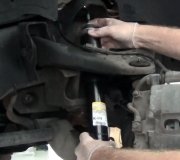Everything I found for reference shows your car uses a common lower ball joint design, but it appears to be used in an unusual way. Most front-wheel-drive cars today use a lower control arm with the lower ball joint cast as part of it. You must replace the assembly which includes the ball joint, control arm, and bushings.
Your type of ball joint is normally pressed into the control arm and both parts can be replaced individually as needed. At the mileage you listed, it would be a better value to replace the ball joint when the control arm must be replaced. The labor time and dollars involved in transferring the old ball joint to the new control arm would exceed the cost of the ball joint.
It looks like the lower ball joint on your car is pressed into the spindle, and the joint's stud goes into the control arm. If that is correct, I do not know what problem the engineers found a solution for, but it should be a simple matter of bolting on the control arm without going through the work of replacing the ball joint.
The other side of the story is if your lower ball joints are original, and your mechanic is already going to be this involved with disassembly, if he has your best interest at heart, he is going to want to replace the ball joints at the same time. The job of replacing them will already be three quarters done so it will only take a few extra minutes to do everything. If he leaves the old ones on the car and they become sloppy in a few months, you will be paying for the labor to do most of the job all over again.
Replacing the control arms means the car will need to be aligned, as no two parts are ever exactly the same. The specialist cannot set the alignment and expect it to hold the wheels in place if a ball joint is sloppy. We do not want to find out he cannot align the car after it has been put back together with worn parts.
Thursday, April 26th, 2018 AT 5:53 PM



